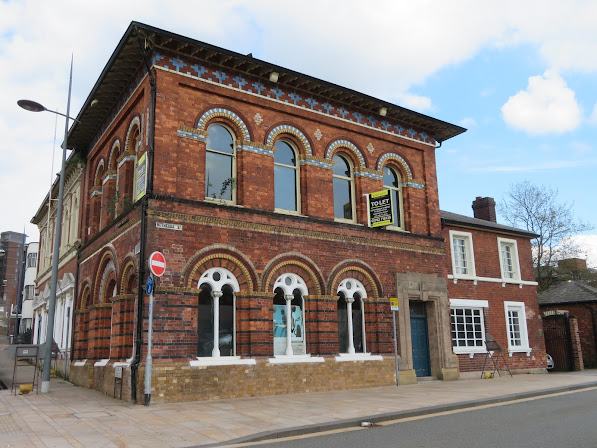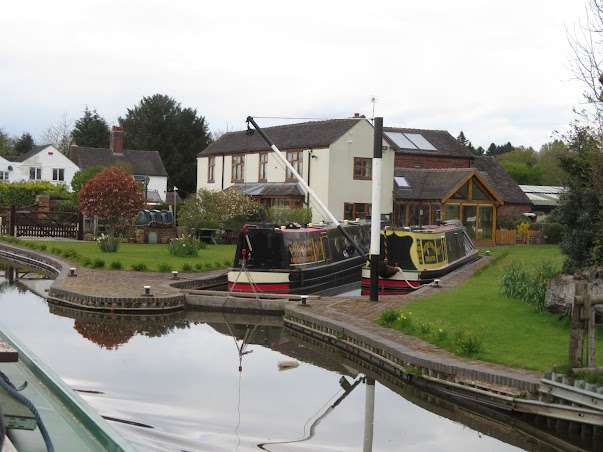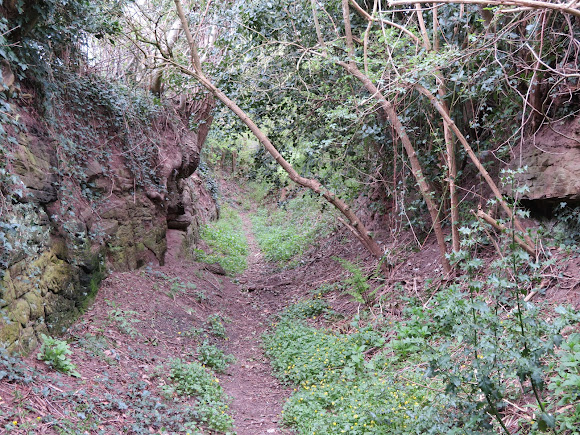It was a lovely sunny morning, but still with the cold wind. I got up to make the tea after the second boat had gone past, Stone bound, about 07:30!
We passed the Wedgewood factory. There was some talk of a factory shop visit but decided against it in the end. Soon we were up through Trentham Lock and heading towards Stoke.
Just before passing the incinerator and Stoke City FC's ground and under the road there are these bogie wheels that form seating. The Michelin Tyre plant is near by so I wonder if they were for moving heavy things around the plant.
This squirrel looked well fed and was not shy as we passed
There is along wharf with brick and door with occasional windows. It was the Colonial Pottery that was built in 1885 by Winkle and Wood. By 1890 Winkle was on his own, and then in 1900's it was sold on to the Hewitt Bros., but they continued to trade as F. Winkle and Co. They later moved from general earthen ware to sanitary products and by 1949 were part of the Doulton Group. The factory was demolished in 2000.
It certainly was a big place. You can see a narrow boat and horse just coming through the bridge.
Just a little further on, on the tow path side is this cross over bridge over a short arm. This was to another pottery that was set up in 1912, Gray's Pottery, set up by Albert Edward Gray. From wholesaling pottery he moved to buying white ware and then hand decorating. He sourced the best designers and artists and his wares were well sort after. He set his factory to make his own pots and made and decorated just about everything. The business was bought by Portmeirion Pottery in 1962 and the name was lost. There was another arm a little further on, on the off side where Dolphin cruisers, line dancing, air rifle range etc is situated. It was called Stoke Basin.
Just a little further on is the Trent Aqueduct. Not quite as impressive as those passed over earlier in the trip. The Trent is almost culveted as it passes on its way to Trent Falls. After starting out on Biddulph Moor it is a bit unglorious for it to be squeezed like this near the start of its 185 mile journey to the Humber.
These are the only bottle kilns that are left of the Cliffe Vale Pottery. The factory was built in 1887 by Twyford's, and it was here that the world's first flushing toilet was manufactured. It closed in 1994 and moved to Alsanger. It looks like student accommodation or flats now.
You cn see the last two bottle kilns next to the canal on the left.
We had help up the Stoke Locks by a couple of blokes who style themselves as 'unofficial' voluntary lock keepers. They were competent and said they were around most of the day. They didn't want to join C&RT as they wanted to please themselves about coming and going, shifts etc. With their help we were soon up at the summit level and making the turn into the Caldon at Etruria. We stopped to fill up with water as we had put a wash on as we headed up the locks.
James Brindley was watching as we topped up the tanks, and as we moved round the corner to find a mooring.
After a bite of lunch we decided to head into Hanley as we had stuff to buy from shops not found by canals. We walked up the towpath of the Trent and Mersey and saw the Round House. This is the only part of Joseph Wedgewood's original pottery built in 1769. Over it's life it was used for grinding colours and materials, a stables, a fire engine housing and a counting house. It was restored in 1885 and there was one on each end of the front of the building.
This old postcard shows the same round house in it hey day. It also shows how there has been a fair bit of subsidence as the roundhouse is now largely below the level of the canal. It is used for exhibitions today.
The municipal Hanley Telephone Exchange was built on four levels in 1900 and was not just thrown up. It has towers, scrool work and wonderful windows. It has escaped unaltered externally by the look of it. Lets hope it survives a bit longer.
On the corner of Foundry and Trinity Streets is this building that looks quite Art Deco but it was the offices of the local newspaper the Staffordshire Sentinel that was built in 1849. However it must have had a face lift later or more likely was rebuilt in the 1930's. It looks like it has been a night club more recently. There can't be too much Art Deco architecture left in the area, so I hope this survives.
This Victorian building is distinguished with it name in Minton Tiles. The building has raised in the 1880's and housed a Repertory Theatre, dance school, iron mongers and Liberal club before hosting Webberleys printers, stationer and booksellers in 1924. The business survived until 2016.

The Bethesda Methodist Chapel was known as the Cathedral of the Potteries. It was built in 1819 and replaced an earlier chapel. It was designed by a local architect in the Italianate style and is one of the largest outside of London. It was Listed Grade II* in 1972, but deteriorated, especially when it closed for worship in 1985. Luckily it is now in the care of the Historic Chapels Trust.
This building has more of the Minton Tiles and stands on the corner of Albion and Bethesda Street and was built in the 1850's It was abandoned in 2005 but was restored in 2018, but it still awaiting a tenant to bring it back to Life.
Outside the Civic Centre were statues of novelist Arnold Bennet and Reginald Mitchell the designer of the Spitfire plane, both local worthies. But I was struck by this stainless steel statue that represents the workers of nearby Shelton Steel Works that are no longer. It was designed and built by Colin Melbourne.
There aren't too many of these back street pubs left now. This one was closed for a long time, but opened again some time before COVID. It looks like it still has separate entrances to the bar and lounge and still has a window with Worthington's Ales etched in it.. The I in Inn looks like it was painted gold at one time. I wonder if all the letters were.
Hanlet may not be the first place on the agenda of visits when you get out and about, but like everywhere there are plenty of things to see if you look.

















































